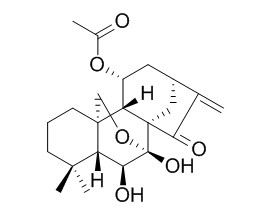Longikaurin E
Longikaurin E induces apoptosis of pancreatic cancer cells via ROS generation to modulate the p38 and PI3K/AKT pathways and could be a promising anti-pancreatic agent.
Inquire / Order:
manager@chemfaces.com
Technical Inquiries:
service@chemfaces.com
Tel:
+86-27-84237783
Fax:
+86-27-84254680
Address:
1 Building, No. 83, CheCheng Rd., Wuhan Economic and Technological Development Zone, Wuhan, Hubei 430056, PRC
Providing storage is as stated on the product vial and the vial is kept tightly sealed, the product can be stored for up to
24 months(2-8C).
Wherever possible, you should prepare and use solutions on the same day. However, if you need to make up stock solutions in advance, we recommend that you store the solution as aliquots in tightly sealed vials at -20C. Generally, these will be useable for up to two weeks. Before use, and prior to opening the vial we recommend that you allow your product to equilibrate to room temperature for at least 1 hour.
Need more advice on solubility, usage and handling? Please email to: service@chemfaces.com
The packaging of the product may have turned upside down during transportation, resulting in the natural compounds adhering to the neck or cap of the vial. take the vial out of its packaging and gently shake to let the compounds fall to the bottom of the vial. for liquid products, centrifuge at 200-500 RPM to gather the liquid at the bottom of the vial. try to avoid loss or contamination during handling.
BMC Complement Altern Med.2018, 18(1):221
Nat Commun.2023 Dec 20;14(1):8457.
Eur J Ther.2023, 29(4):900-906.
Int. J. Mol. Sci.2022, 23(8), 4130.
Journal of Herbal Medicine2024, 48:100950
Front Pharmacol.2022, 13:906763.
Biochem Biophys Res Commun.2020, 522(4):1052-1058
Food Funct.2022, 13(23):12105-12120.
Antiviral Res.2013, 98(3):386-93
J Cell Biochem.2018, 119(2):2231-2239
Related and Featured Products
Planta Med 2006; 72(8): 740-745.
Antiproliferative ent-Kauranoids from Isodon parvifolius[Reference:
WebLink]
Nine new 7α,20-epoxy-ent-kaurane diterpenoids, parvifolines O - W (1 - 9), together with five known analogues, lasiocarpanin (10), rosthorin A (11), Longikaurin E (12), adenolin D (13) and longikaurin B (14), were isolated from the leaves of Isodon parvifolius.
METHODS AND RESULTS:
Their structures were determined by means of spectroscopic analysis. Selected diterpenoids (1 - 10) were tested for their antiproliferative activity against A549, HT-29 and K562 cells.
CONCLUSIONS:
Compounds 3, 7, 8 and 10 showed moderate inhibitory activity against all three cell lines.
Naunyn Schmiedebergs Arch Pharmacol. 2015 Jun;388(6):623-34.
Longikaurin E induces apoptosis of pancreatic cancer cells via modulation of the p38 and PI3K/AKT pathways by ROS.[Pubmed:
25743573]
Pancreatic cancer is a devastating disease with a poor prognosis. It ranks as the fourth or fifth most common cancer in men and women and has the lowest 5-year survival rate. Therefore, there is an urgent need to develop novel therapeutic agents for pancreatic cancer. Longikaurin E (LE), which is derived from the traditional herbal medicine Rabdosia longituba, had been reported to have anti-proliferative and pro-apoptotic properties in several types of cancers.
METHODS AND RESULTS:
In this study, we investigated the cytotoxic properties of LE against pancreatic cancer cells and explored the mechanism behind the observed apoptosis. Pancreatic cancer cell lines cultured in the presence of LE exhibited dose- and time-dependent growth suppression by clone formation, methylthiazoltetrazolium assay, lactate dehydrogenase cytotoxicity assay, and fluorescence-activated cell sorting analysis, respectively. In addition, these culture conditions also induced the generation of cellular reactive oxygen species (ROS). In order to determine the mechanisms underlying LE-induced cytotoxicity, we used reverse transcription polymerase chain reaction and Western blot analysis in the pancreatic cancer cell line PANC1. The results showed that the expression of Bax was noticeably upregulated and the expression levels of Bcl-2, Bcl-XL, survivin, and c-Myc were significantly downregulated. We also observed increased p38 phosphorylation and decreased phosphorylation of the PI3K/AKT pathway. Interestingly, we also found that LE activated caspase-3. However, N-acetyl-L-cysteine, a kind of antioxidant, reversed all of these cellular activities.
CONCLUSIONS:
In conclusion, this study suggested that LE induced apoptosis of pancreatic cancer cells via ROS generation to modulate the p38 and PI3K/AKT pathways and could be a promising anti-pancreatic agent.



